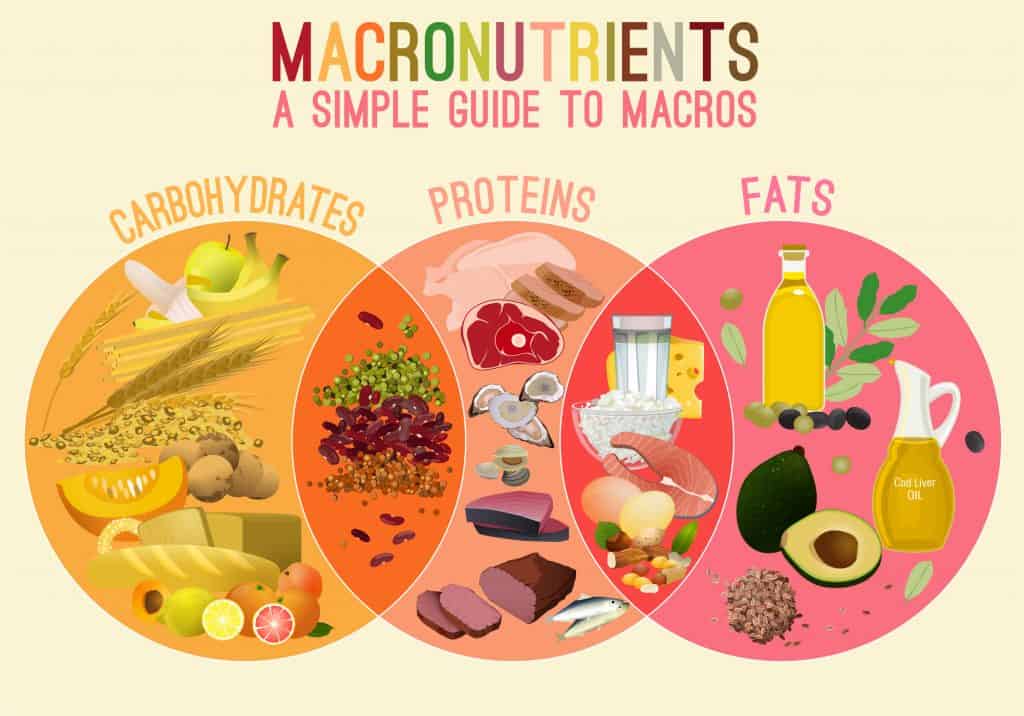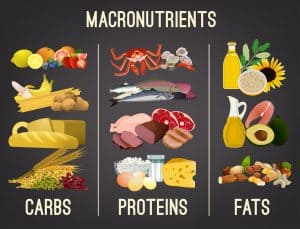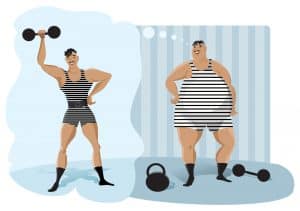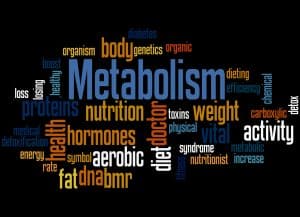You’re cutting for a competition or maybe a summertime.
Halfway through your diet, you feel a bit pale.
Like … you need a break but not in a way that will mess up your physique …
Especially after spending months sculpturing it to look like a Greek figure!
Or … maybe you did a dirty bulk in the off-season and now you have to diet back for more than 3 or even 4 months.
So after 3 months and you hit a fat loss plateau that you can’t breakthrough.
That’s when the refeed day comes in!
In this post, I’ll share with you everything you need to know about doing a refeed day when cutting in a simple Q&A format.
- Table of Contents
What is a Refeed day?
A refeed day is a day on which you increase your caloric intake after a relatively long period of being on a calorie-restricted diet.
Think of it as a day-long break from the caloric deficit to counteract the negative sides of weight loss, such as lower hormone levels, nervous system fatigue, lethargy, and weight loss plateau.
This increase in calorie consumption is well-controlled and planned. There is a limit to how much you eat and the type of food you should consume.
How does the Refeed Day Work When Cutting?
To answer this question, it’s important to distinguish between two phases of weight loss.
Stage 1: when you first start losing fat from being on a caloric deficit, the levels of a hormone called Leptin start to decline.
Leptin is the hunger and appetite hormone. It’s produced by the fat cells in the body.
So when you start to lose fat, Leptin decreases.
This is a good sign because the drop in Leptin, initially, helps boost your metabolism and regulate your hunger.
Stage 2: when you continue to be on a caloric deficit for a long time, Leptin levels fall off sharply.
This is a warning to the body that it has inadequate fat storage (remember in a caloric deficit fat is the main energy source for the body).
Eating fewer calories than your body is used to for a long period in order to lose fat is not a normal process for the body.
Hence, the body starts to counter this effect by alerting your brain to signal an increase in cravings to make you eat more food and fight fat loss.
This protective process is called Adaptive Thermogenesis.
When you enter this stage, you hit a fat loss plateau and you start to feel fatigued!
By including a refeed day, the increase in caloric intake temporarily boosts the levels of Leptin.
Your body then reduces the cravings and resumes the fat loss process efficiently.
The benefits of Refeed Day when Dieting

There are many benefits to having a refeed day when dieting. Here are a few:
1
Breakthrough fat loss plateaus.
When the levels of Leptin increase through food manipulation on the refeed day, the body stops resisting the fat loss process.
2
Stops cravings and improves mental health.
Again because of the enhancement of Leptin levels, the signal your brain sends to your body in order to crave food stops.
This results in suppression of appetite and an improvement in mental mood.
3
Increase in physical strength.
Because of the increase in the calories introduced, your body now has an available source of energy and you should notice an increase in the weights you lift.
4
Increase in muscularity.
Energy from the extra calories consumed on the refeed day (especially carbohydrates) is stored in the muscle in the form of glycogen, which increases the Sarcoplasmic (fluid surrounding muscle fibers) and causes an increase in muscle size.
This is why bodybuilders look impressively full and massive on the competition day when they pump up the calories.
We wrote about this effect in this article about muscle hypertrophy, and carb cycling.
The downfalls of the Refeed Day when Dieting
The biggest side effect of the refeed day I see among lifters and dieters is an increase in the appetite the day following the refeed day.
But why does this happen?
The main macronutrient recommended for the refeed day when cutting is carbohydrate as we mentioned below.
When you increase the carbohydrate intake your pancreas increases insulin sensitivity.
This will elevate the glucose levels in the bloodstream. Which is generally a positive sign.
The bad thing is that this elevation in insulin is spike-like. When you stop consuming large amounts of carbs the following day, your insulin drops immediately. You crash! You feel hungry and become vulnerable to food overconsumption if you don’t control your appetite.
In order to alleviate this effect, we recommend including some healthy fats with the carbohydrates in each meal. This way the insulin levels remain elevated for a relatively long period of time.
When should you do a Refeed day?
At a minimum, you should do a refeed day after 2 -3 months from the day you start the diet.
You should not attempt to do a refeed day unless one of the following 4 signs happens:
1
The scale is not moving.
The main keyword here is “after 2 – 3 months of dieting”. That’s when you are consistently losing weight week after week but struggling to see changes in the last two weeks or so.
2
Having low energy and a great drop in strength.
This is a sign that you lack enough energy/fat storage and you need a boost in carbohydrate intake.
3
Feeling Fatigued.
This is a sign that your nervous system is exhausted and needs a break.
4
Mood swings.
This is very common among lifters when approaching a contest day or when they’ve been dieting for a very long time after a dirty bulk.
When your brain does not get enough glucose (sugar), the hypothalamus (the part of your brain responsible for emotional response among other functions) signals your body to produce the hunger hormone.
Refeed Day Calculator - How Much Should You Eat On the Refeed Day?
Ok, so we mentioned that on a refeed day you increase your caloric intake.
But by how much?
You should increase your calorie consumption on the refeed day to the levels of your current TDEE, Total Daily Energy Expenditure.
TDEE is the total daily calories you need to maintain your current body weight, not the previous body weight when you started the diet.
When you start cutting, you reduce the caloric intake by 20 – 30% of the TDEE.
So, on the refeed day, you increase the calories to the new TDEE Kcal levels after you lost some fat.
Here is a detailed example:
Say, you are a 5’ 9” tall, 25 years old, male, weighing 250 pounds, and you workout 3-4 times a week.
Your TDEE is about 3000 Kcal.
You plan to consume about 25% less than your TDEE, which is 2250 Kcal.
You start the diet and you consistently lose fat at about 1.5 pounds per week.
After two months (8 weeks) you reach 238 pounds.
You hit a plateau and feel lethargic, so you want a refeed day.
On the refeed day, you calculate your current TDEE:
Now given that you are 5’ 9”, 25 years old, male, weighing 238 pounds now, and you workout 3-4 times a week:
Your current TDEE = 2922 Kcal.
And that’s how many calories you should consume on your refeed day.
Use this calculator to figure out your TDEE.
What to Eat On A Refeed Day
As we mentioned earlier, a refeed day is not a cheat day. You are limited to eating up to your TDEE calories only.
You are also restricted to a certain type of macronutrient …
Carbohydrates. And not from junk sources.
The idea here is that 1 gram of carbohydrates contains 4 calories only while 1 gram of fat has 9 calories, which is over 2x the calories in carbs!
So you eat more and provide a quick source of energy to the body.
Here is a list of suggested carbohydrate sources to enjoy and others to avoid:
- Carbs to Enjoy
- Pasta.
- Rice and Rice Cakes.
- Cereal.
- Bread.
- Potatoes and Sweet Potatoes.
- Fruit Juice – No added sugar.
- Carbs to Avoid
- Beer.
- Pizza.
- Cakes.
- Candy.
- donuts.
Refeed Day Macros When Dieting

Now off the TDEE, how much carbohydrates should you eat?
When dieting, it’s recommended you do the following split between the daily macronutrients:
- 50% protein.
- 30% carbs.
- 20% fats.
Since both protein and carbohydrates have the same amount of calories per 1 gram, i.e. 4 calories, you can now slightly reduce the protein intake and increase carbohydrates by the same amount without having to exceed your TDEE calorie intake on the refeed day.
For example, the refeed day should look like this:
- 30 – 40% protein.
- 50 – 40% carbs.
- 20% fats.
Notice that the fat percentage does not change. It’s important to keep the fat at the exact same levels.
Now, use the macro calculator below to translate the macro percentage from the refeed day to the exact number of grams from each macronutrient.
In our example above, for a total of 2922 Kcal, if we use the following macro percentage on the refeed day:
- 30% protein.
- 50 % carbs.
- 20% fats.
This should translate to:
- 220 grams of protein.
- 366 grams of carbs.
- 64 grams of fats.
Should You Do a Refeed On a Rest Day?
Yes! It is definitely recommended to do a refeed day on your day off for mental sanity and enjoyment.
Other than that, here are the three main reasons:
1
Less protein and more carbs.
You don’t need as much protein on your days off as for your workout days. So, you substitute that amount with more carbohydrates.
2
Carbs are not burned as fast during the rest days.
When you workout, the first source of energy that the body uses is carbohydrates. You don’t want your carbohydrate reserves to be consumed quickly and depleted on a workout day.
3
Recover your central nervous system.
When combining rest and refeed on the same day, your body uses the extra amounts of carbs to recover muscular and central nervous fatigue.
This way you should notice enhanced strength, mental focus, and improved mood the day following the refeed day.
Refeed day vs Cheat day vs. Reverse Dieting vs. If it fits your macros vs. Carb Cycling
It is important to know the differences between those terms that are frequently used in the fitness and bodybuilding space.
Refeed day: Takes place during the dieting/cutting phase. It is thoughtful and planned. And has a limit on the macros and the type of food used. It will actually help accelerate your fat loss.
Cheat day: Also takes place during dieting. But, it has no limit on the number of calories or the type of food consumed. It will set you back for at least a week or two and retard your weight loss progress.
Reverse dieting: Takes place “after” the diet is finished and your goal is accomplished. It is a gradual increase in caloric intake until you reach your TDEE. It also has a limit on the type of food consumed. No junk.
Flexible dieting -If it fits your macros: Takes place when you are on a clean bulk or body weight-maintenance phase. It has a limit on macros but not the type of food consumed.
Carb cycling: can be done during both the cutting or bulking phase. Unlike the refeed day, when incorporating carb cycling, you do not increase the amount of daily caloric intake! You still limit your calories while increasing the percentage of carbohydrates at the expense of protein.
The Takeaway
- A refeed day when cutting is a planned increase in caloric intake 2 or 3 months into your diet.
- It will boost your metabolism as it decreases the Leptin (hunger hormone) levels in the body.
- Your calories should be limited to your current total daily energy expenditure (TDEE) calories.
- 40% to 50% of your caloric intake on the refeed day when dieting should come from carbohydrates and not junk food.
- It is recommended that you do your refeed day on a rest day.
- Finally, it is important to know the difference between the following nutritional regimes and when to use each one: refeed day, reverse dieting, cheat day, reverse dieting, and carb cycling.













